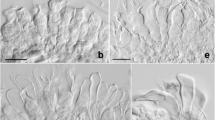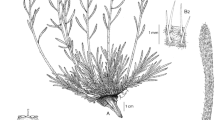Abstract
A rust causing leaf spotting and distortion of twigs and branches of Caesalpinia scortechinii in Queensland is described as the new species Bibulocystis gloriosa. Uredinia and telia occur on spotted pinnules, and pycnia, aecial uredinia and telia on galled and twisted leaf rachides, twigs and branches. B. gloriosa is similar to Bibulocystis viennotii on Albizia granulosa in New Caledonia in having a macrocyclic life cycle with all spore states, and teliospores with two fertile cells and two cysts. It differs in having aecial urediniospores and urediniospores with uniformly thickened walls and several scattered germ pores, rather than the apically thickened walls and equatorial germ pores of B. viennotii. Teliospores in the two species are similar in size, but those of B. gloriosa have proportionally larger fertile cells and smaller cysts than in B. viennotii. To date, B. gloriosa is known from only two localities in south-eastern Queensland. Comparison with the type specimen of Spumula caesalpiniae on Caesalpinia nuga from Indonesia has shown that the two rusts are generically distinct.
Similar content being viewed by others
References
Berndt R (1996) Comparative studies on the teliospore morphology and ontogeny of Spumula serispora, spec. nova, and Ravenelia texensis (Uredinales, Raveneliaceae). Plant Systematics and Evolution 200, 79–88. doi: 10.1007/BF00984749
Boedijn KB (1959) The Uredinales of Indonesia. Nova Hedwigia 1, 463–498.
Brummitt RK, Powell CE (Eds) (1992) ‘Authors of plant names.’ (Royal Botanic Gardens: Kew, UK)
Cummins GB (1959) ‘Illustrated genera of rust fungi.’ (Burgess Publishing Company: St Paul, MN)
Cummins GB, Hiratsuka Y (1983) ‘Illustrated genera of rust fungi.’ 2nd edn. (The American Phytopathological Society: St Paul, MN)
Cummins GB, Hiratsuka Y (2003) ‘Illustrated genera of rust fungi.’ 3rd edn. (The American Phytopathological Society: St Paul, MN)
Hiratsuka Y (1973) The nuclear cycle and the terminology of spore states in Uredinales. Mycologia 65, 432–443. doi: 10.2307/3758114
Hiratsuka Y, Cummins GB (1963) Morphology of the spermogonia of the rust fungi. Mycologia 55, 487–507. doi: 10.2307/3756340
Hiratsuka Y, Hiratsuka N (1980) Morphology of spermogonia and taxonomy of rust fungi. Reports of the Tottori Mycological Institute (Japan) 18, 257–268.
Hnatiuk RJ (1990) ‘Census of Australian vascular plants.’ Australian Flora and Fauna Series No. 11 (Australian Government Publishing Service: Canberra)
Holmgren PK, Keuken W, Schofield EK (1981) ‘Index Herbariorum. Part I. The herbaria of the world.’ 7th edn. (Bohn, Scheltema and Holkema: Utrecht, The Netherlands)
Huguenin B (1966) Micromycètes du Pacifique Sud. (Cinquième contribution). Urédinales de Nouvelle-Calédonie (I). Bulletin de la Société Mycologique de France 82, 248–273.
Kirk PM, Cannon PF, David JC, Stalpers JA (2001) ‘Ainsworth and Bisby’s dictionary of the fungi.’ 9th edn. (CAB International: Wallingford, UK)
Laundon GF (1967) Terminology in the rust fungi. Transactions of the British Mycological Society 50, 189–194.
Laundon GF (1972) Delimitation of aecial from uredinial states. Transactions of the British Mycological Society 58, 344–346.
Laundon GF (1973) Uredinales. In ‘The fungi.Anadvanced treatise vol. IVB.’ (Eds GC Ainsworth, FK Sparrow, AS Sussman) pp. 247–279. (Academic Press: New York)
Mains EB (1935) Spumula, a new genus of rusts. Mycologia 27, 638–641. doi: 10.2307/3754177
McNeill J, Barrie FR, Burdet HM, Demoulin V, Hawksworth DL, et al. (2006) ‘International code of botanical nomenclature (Vienna Code).’ (Koeltz Scientific Books: Koenigstein, Germany)
Pascoe IG, Sutton BC (1986) Terms for the disposition of lesions and fungal structures on laminar leaves and phyllodes. Australasian Plant Pathology 15, 78–80. doi: 10.1071/APP9860078
Savile DBO (1968) The case against ‘uredium’. Mycologia 60, 459–464. doi: 10.2307/3757182
Savile DBO (1988) Terminology of spore states in Uredinales. Mycotaxon 33, 387–389.
Walker J, Beilharz V, Pascoe IG, Priest MJ (2006) Bibulocystis gen. nov. (Uredinales) on Daviesia (Fabaceae) and Albizia (Mimosaceae) in Australasia, with comments on the genera Cystomyces and Dicheirinia and rust genera with teliospore cysts. Australasian Plant Pathology 35, 1–22. doi: 10.1071/AP05099
Wiecek B, McCune S (1991) Caesalpinia. In ‘Flora of New South Wales vol. 2.’ (Ed. GJ Harden) pp. 314–315. (Royal Botanic Gardens: Sydney)
Author information
Authors and Affiliations
Corresponding author
Rights and permissions
About this article
Cite this article
Walker, J., Shivas, R.G. Bibulocystis gloriosa sp. nov. (Pucciniales) on Caesalpinia scortechinii in Queensland, with comments on Spumula caesalpiniae . Australasian Plant Pathology 38, 29–35 (2009). https://doi.org/10.1071/AP08073
Received:
Accepted:
Issue Date:
DOI: https://doi.org/10.1071/AP08073




